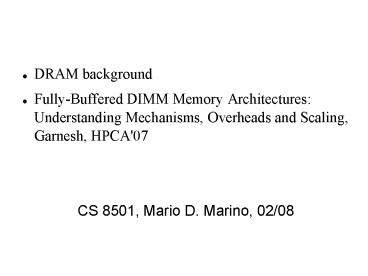DRAM background - PowerPoint PPT Presentation
Title:
DRAM background
Description:
DRAM background Fully-Buffered DIMM Memory Architectures: Understanding Mechanisms, Overheads and Scaling, Garnesh, HPCA'07 CS 8501, Mario D. Marino, 02/08 – PowerPoint PPT presentation
Number of Views:80
Avg rating:3.0/5.0
Title: DRAM background
1
- DRAM background
- Fully-Buffered DIMM Memory Architectures
Understanding Mechanisms, Overheads and Scaling,
Garnesh, HPCA'07 - CS 8501, Mario D. Marino, 02/08
2
- DRAM Background
3
Typical Memory
- Busses address, command, data, DIMM (Dual
In-Line Memory Module) selection
4
DRAM cell
5
DRAM array
6
DRAM device or chip
7
Command/data movement DRAM chip
8
Operations(commands)?
- protocol, timing
9
Examples of DRAM operations(commands)?
10
(No Transcript)
11
- The purpose of a row access command is to move
data from the DRAMarrays to the sense
amplifiers. - tRCD and tRAS
12
- A column read command moves data from the array
of sense amplifiers of a given bank to the memory
controller. - tCAS, tBurst
13
- Precharge separate phase that is a prerequisite
for the subsequent phases of a row access
operation (bitlines set to Vcc/2 or Vcc)?
14
- Organization, access, protocols
15
- Logical Channels set of physical channels
connected to the same memory controller
16
Examples of Logical Channels
17
Rank set of banks
18
(No Transcript)
19
Row DRAM page
20
Width aggregating DRAM chips
21
Scheduling banks
22
Scheduling banks
23
Scheduling ranks
24
Open x Close page
- Open-page data access to and from cells requires
separate row and column commands - Favors accesses on the same row (sense aps open)?
- Typical general purpose computers
(desktop/laptop)? - Close-page
- Intense amount of requests, favors random
accesses - Large multiprocessor/multicore systems
25
Available Parallelism in DRAM System Organization
- Channel
- Pros performance
- different logical channels, independent memory
controllers - schedulling strategies
- cons
- Number of pins, power to deliver
- Smart but not adaptive firmware
26
Available Parallelism in DRAM System Organization
- Rank
- pros
- accesses can proceed in parallel in different
ranks (busses availability)? - cons
- Rank-to-rank switching penalties in high
frequency - Globally synchronous DRAM (global clock)?
27
Available Parallelism in DRAM System Organization
- Bank
- Different banks (busses availability)?
- Row
- Only 1 row/bank can be active at any time period
- Column
- Depends on management (close-page / open-page)?
28
- Paper Fully-Buffered DIMM Memory Architectures
Understanding Mechanisms, Overheads and Scaling,
Garnesh, HPCA'07
29
(No Transcript)
30
Issues
- parallel bus scaling frequency, widths, length,
depth (man hops gt latency )? - memory controllers increased CPUs, GPUs
- DIMMs/channel (depth) decreases
- 4DIMMs/channel in DDRs
- 2 DIMMs/channel in DDR2
- 1 DIMM/channel in DDR3
- scheduling
31
Contributions
- Applied DDR based memory controller policies in
FBDIMM memory - Evaluation of Performance
- Exploit FBDIMM depth rank (DIMM) parallelism
- latency and bandwidth for FBDIMM and DDR
- high utilization of the channels, FBDIMM
- 7 in latency
- 10
- low utilization of the channels
- 25 in latency
- 10 in bandwidth
32
- Northbound channel reads / Southbound-channel
writes - AMB pass-through switch, buffer, serial/parallel
converter
33
Methodology
- DRAMsim simulator
- Execution-driven simulator
- Detailed models of FBDIMM and DDR2 based on real
standard configurations - Standalone / coupled with M5/SS/Sesc
- Benchmarks bandwidth-bound
- SVM from Bio-Parallel (r90)?
- SPEC-mixed 16 independent (rw 21)?
- UA from NAS (rw 32)?
- ART (SPEC-2000, OpenMP) (rw 21)?
34
Methodology cont
- Different scheduling policies greedy, OBF,
most/last pending and RIFF - 16-way CMP, 8MB L2
- Multi-threaded traces gathered with CMPim
- SPEC traces using Simplescalar with 1MB L2,
in-order core - 1 rank/DIMM
35
- High-bandwidth utilization
- Better bandwidth FBDIMM
- Larger latency
36
- ART and UA latency reduction
37
- Low utilization serialization cost
- Depth FBDIMM scheduler offsets serialization
38
- Overhead queue, south and rank availability
- Single-rank higher latency
39
Scheduling
- Best RIFF, priority on reads than writes
40
- Bandwidth is less sensitive th Higher latency in
open-page mode - More channels gt decreases channel utilization































